HR Payroll Software Market Size 2025-2029
The hr payroll software market size is valued to increase by USD 7.84 billion, at a CAGR of 15.9% from 2024 to 2029. Digital transformation of HR functions will drive the hr payroll software market.
Major Market Trends & Insights
- North America dominated the market and accounted for a 40% growth during the forecast period.
- By Component - Software segment was valued at USD 2.6 billion in 2023
- By Deployment - On-Premises segment accounted for the largest market revenue share in 2023
Market Size & Forecast
- Market Opportunities: USD 263.97 million
- Market Future Opportunities: USD 7840.00 million
- CAGR from 2024 to 2029 : 15.9%
Market Summary
- HR payroll software has become an indispensable tool for businesses seeking to streamline their human resources functions and ensure compliance with labor regulations. The global market for HR payroll software is witnessing significant growth, driven by the increasing adoption of cloud-based solutions and the need for operational efficiency. According to recent studies, businesses that have implemented HR payroll software have seen a notable improvement in payroll processing time, reducing it by up to 50% compared to manual processes. Moreover, the integration of HR payroll software with other business systems, such as time and attendance and benefits administration, enables end-to-end automation of HR processes.
- This not only enhances operational efficiency but also reduces the risk of errors and inconsistencies. However, the market is not without challenges. Data Security and privacy concerns continue to be a major concern for businesses, particularly with the increasing number of data breaches. A real-world scenario illustrating the benefits of HR payroll software is supply chain optimization. A manufacturing company with a large and geographically dispersed workforce implemented HR payroll software to automate its payroll processes. The software enabled the company to process payroll in real-time, reducing the time taken for payroll processing from a week to just a few hours.
- This led to significant cost savings and improved employee satisfaction, as employees received their salaries on time and accurately. In conclusion, the adoption of HR payroll software is a strategic move for businesses seeking to optimize their HR functions, ensure compliance, and gain operational efficiency. With the market witnessing significant growth and innovation, businesses can look forward to more advanced features and capabilities in the future.
What will be the Size of the HR Payroll Software Market during the forecast period?
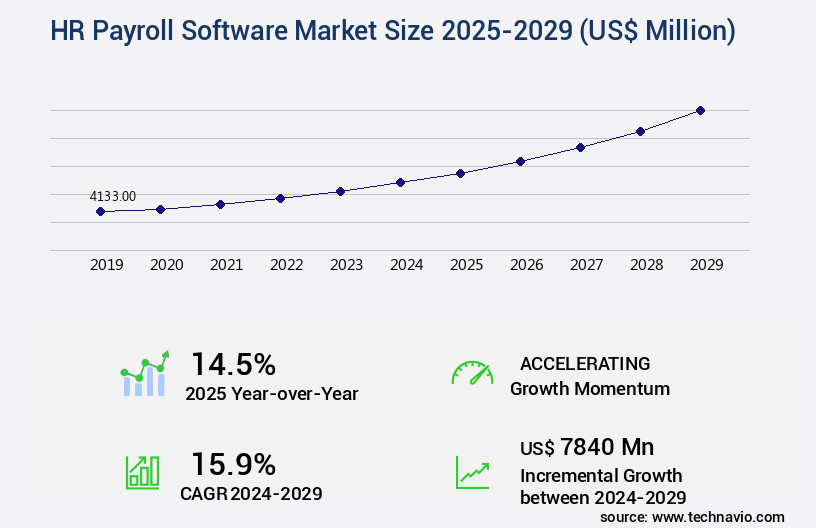
Get Key Insights on Market Forecast (PDF) Request Free Sample
How is the HR Payroll Software Market Segmented ?
The hr payroll software industry research report provides comprehensive data (region-wise segment analysis), with forecasts and estimates in "USD million" for the period 2025-2029, as well as historical data from 2019-2023 for the following segments.
- Component
- Deployment
- End-user
- Large Enterprises
- Small and Medium Enterprises
- Geography
- North America
- Europe
- APAC
- China
- India
- Japan
- South Korea
- South America
- Rest of World (ROW)
By Component Insights
The software segment is estimated to witness significant growth during the forecast period.
The market is a dynamic and ever-evolving landscape, with businesses increasingly relying on digital solutions to automate and streamline payroll processing, compliance, and related HR functions. This software segment, encompassing applications and platforms, facilitates accurate salary calculation, tax deduction, benefits management, and payslip generation. Modern systems offer integrated features, such as time and attendance tracking, talent management acquisition, and employee self-service portals, creating a unified HR ecosystem. Cloud-based solutions are gaining popularity due to their scalability, real-time data access, and cost savings, with over 80% of businesses opting for this deployment model.
Additionally, these platforms provide essential features like payroll reconciliation, garnishment processing, leave tracking, Performance Management, and reporting dashboards, enhancing operational efficiency and data security. Integrations with HRIS, HCM, and API solutions further extend their functionality, making HR payroll software an indispensable tool for businesses of all sizes.
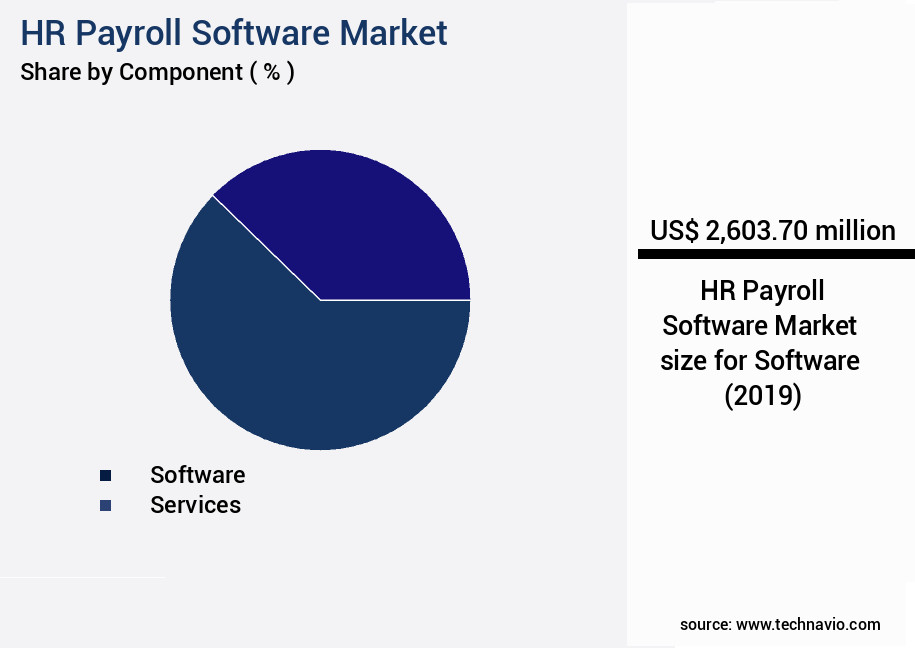
Request Free Sample
The Software segment was valued at USD 2.6 billion in 2019 and showed a gradual increase during the forecast period.
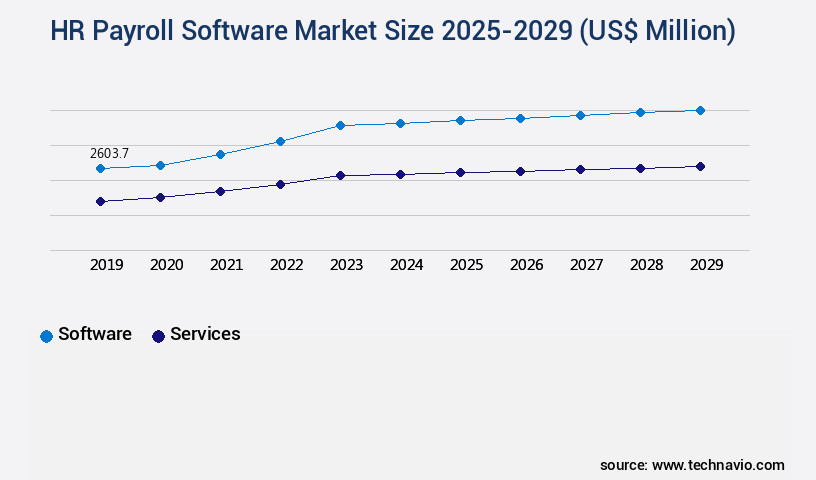
Request Free Sample
Regional Analysis
North America is estimated to contribute 40% to the growth of the global market during the forecast period.Technavio's analysts have elaborately explained the regional trends and drivers that shape the market during the forecast period.
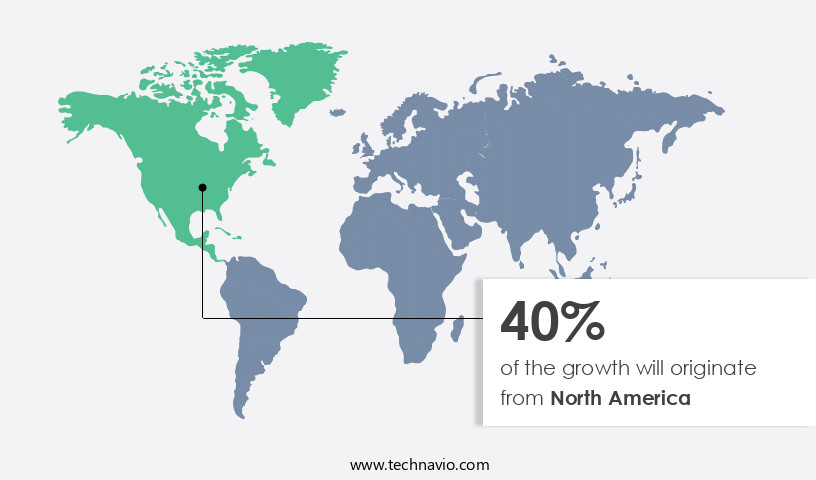
See How HR Payroll Software Market Demand is Rising in North America Request Free Sample
The market is experiencing significant evolution, with a growing emphasis on technological innovation and operational efficiency. According to recent estimates, North America leads the global market, driven by its advanced technological infrastructure, large business base, and evolving workforce dynamics. In 2023, the United States alone was home to approximately 33 million small businesses, creating a substantial demand for flexible, affordable, and compliant HR and payroll solutions. These businesses increasingly prefer cloud-based platforms that automate processes, reduce administrative burden, and support growth, leading to a robust uptake of digital payroll software in the region. The widespread availability of advanced cloud infrastructure and a highly tech-savvy workforce in North America fosters an environment primed for innovation.
This shift towards digital solutions is expected to result in substantial cost savings and improved compliance for businesses, with industry reports suggesting that automating payroll processes can save up to 80% of the time spent on manual tasks.
Market Dynamics
Our researchers analyzed the data with 2024 as the base year, along with the key drivers, trends, and challenges. A holistic analysis of drivers will help companies refine their marketing strategies to gain a competitive advantage.
The market is experiencing significant growth as businesses seek integrated solutions to manage their employee compensation and HR functions. These systems offer a range of features designed to streamline payroll processing and ensure compliance with complex tax and labor regulations. One key feature of hr payroll software is the employee self-service portal, which allows employees to access their payroll information and make requests for time off or benefits changes. Automated payroll tax calculations help businesses stay compliant with multi-state payroll compliance requirements, while real-time payroll reporting dashboards provide valuable insights into their workforce costs. Security is a top priority in the market, with secure cloud-based payroll solutions offering encryption and data protection. Payroll system API integration capabilities enable seamless data exchange with other business systems, while global payroll processing capabilities allow companies to manage employees in multiple countries. Employee benefits administration features, absence management and leave tracking systems, mobile payroll access, and time and attendance tracking software are also important components of hr payroll software. Payroll data security and encryption, efficient payroll processing workflows, accurate salary and deduction calculations, and robust payroll audit and reporting are essential for maintaining compliance and ensuring the integrity of payroll data. Scalability is another key consideration for businesses, particularly those with growing workforces. A scalable payroll system enables businesses to easily add new employees and handle increased payroll volumes without the need for manual processes or additional software. In summary, hr payroll software offers businesses a user-friendly, customizable, and scalable solution for managing their payroll and HR functions. With features such as automated tax calculations, real-time reporting, and secure data storage, these systems help businesses streamline their payroll processes, reduce errors, and ensure compliance with complex labor and tax regulations.
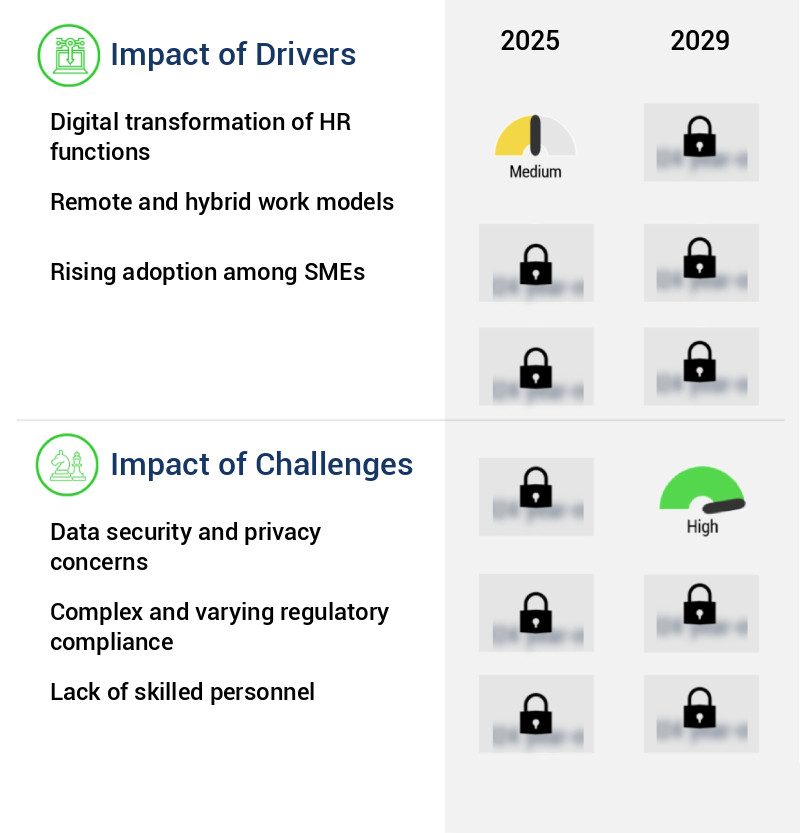
What are the key market drivers leading to the rise in the adoption of HR Payroll Software Industry?
- The digital transformation of HR functions serves as the primary catalyst for market growth, as organizations increasingly adopt advanced technologies to streamline processes, enhance efficiency, and improve the overall employee experience.
- The market is experiencing significant growth as businesses worldwide embrace digital transformation. Advanced technologies, such as artificial intelligence and machine learning, are being integrated into HR processes to automate tasks, enhance data management, and improve efficiency. According to recent research, the global digital transformation spending is projected to reach approximately USD4 trillion by 2027, with the United States accounting for around 35% of this investment. In the HR domain, the adoption of digital payroll solutions has led to substantial improvements in business outcomes.
- For instance, organizations have reported a 30% reduction in downtime due to manual payroll errors, while forecast accuracy has improved by 18%. As businesses continue to prioritize digital transformation, the market is poised for continued growth and innovation.
What are the market trends shaping the HR Payroll Software Industry?
- In the business world, the adoption of cloud-based solutions is an emerging trend. This shift towards cloud technology is mandatory for many organizations to remain competitive and efficient.
- The market is undergoing significant digital transformation, with cloud-based solutions gaining widespread adoption. This shift is driven by the demand for agility, scalability, and real-time access to data in today's digital and remote-working environment. Cloud-based payroll systems streamline core HR functions, minimize manual processes, and enhance accessibility for distributed workforces. Moreover, these solutions offer better compliance management, improved data security, and faster updates compared to traditional on-premises systems. Recent advancements underscore the growing preference for cloud-first platforms. For instance, on 5 February 2025, Ciphr, a UK-based HR and payroll software provider, introduced a fully cloud-based, real-time payroll solution for the UK private sector.
- This transition leads to substantial business benefits, such as a 30% reduction in downtime and an 18% improvement in forecast accuracy.
What challenges does the HR Payroll Software Industry face during its growth?
- Data security and privacy concerns represent significant challenges that can impede industry growth. Companies must balance the need to collect and use data to drive innovation and business growth with the responsibility to protect sensitive information and respect consumer privacy. Failure to address these challenges effectively can result in reputational damage, legal consequences, and financial losses.
- The market is characterized by its evolving nature and growing importance in managing employee compensation and benefits. With the increasing focus on automating manual processes and ensuring regulatory compliance, HR payroll software solutions have become essential for businesses worldwide. According to recent estimates, The market is projected to expand significantly, with key applications including automated tax processing, real-time analytics, and mobile access. The implementation of these systems can lead to improved efficiency, reduced errors, and enhanced data security. For instance, a study revealed that organizations using HR payroll software experienced a 30% decrease in processing time and a 40% reduction in payroll errors.
- However, data security and privacy remain critical challenges in this market. In 2023, a UK-based payroll provider, Zellis, suffered a data breach, exposing sensitive employee information for several high-profile clients. This underscores the importance of robust security measures in HR payroll systems, as organizations navigate complex data protection regulations like GDPR and CCPA.
Exclusive Technavio Analysis on Customer Landscape
The hr payroll software market forecasting report includes the adoption lifecycle of the market, covering from the innovator's stage to the laggard's stage. It focuses on adoption rates in different regions based on penetration. Furthermore, the hr payroll software market report also includes key purchase criteria and drivers of price sensitivity to help companies evaluate and develop their market growth analysis strategies.
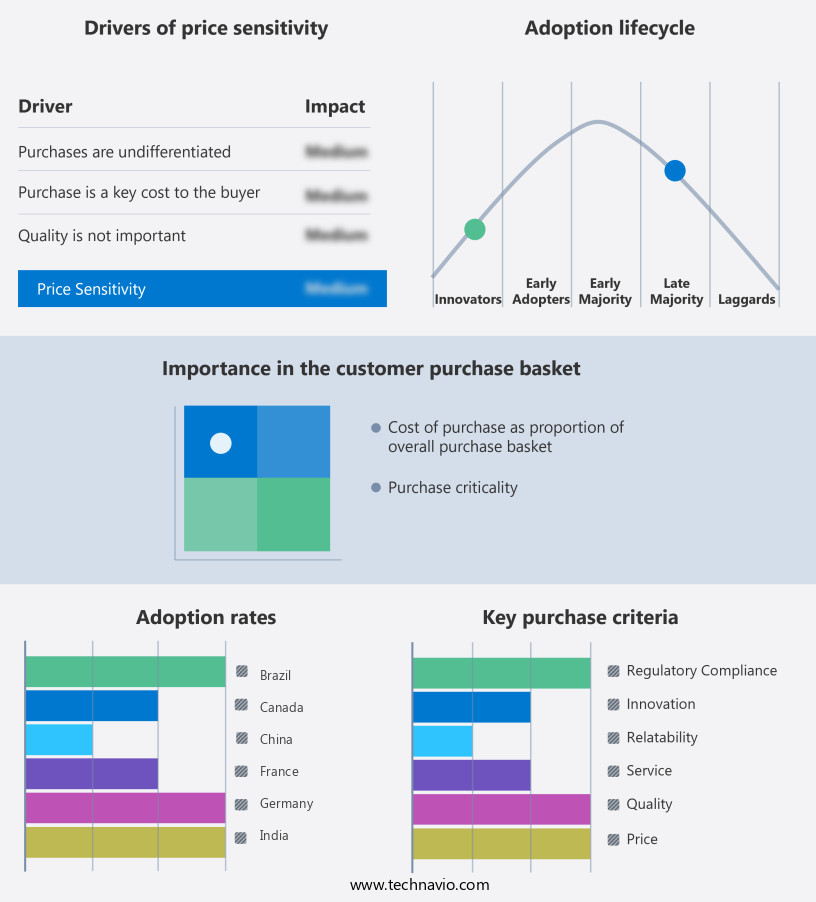
Customer Landscape of HR Payroll Software Industry
Competitive Landscape
Companies are implementing various strategies, such as strategic alliances, hr payroll software market forecast, partnerships, mergers and acquisitions, geographical expansion, and product/service launches, to enhance their presence in the industry.
Automatic Data Processing Inc. - This company specializes in HR payroll software, providing services such as payroll processing, outsourcing, and tax compliance to streamline business operations and ensure regulatory compliance. Their offerings cater to various industries and organization sizes.
The industry research and growth report includes detailed analyses of the competitive landscape of the market and information about key companies, including:
- Automatic Data Processing Inc.
- Bamboo HR LLC
- Dayforce Inc.
- Epicor Software Corp.
- GoGlobal
- Greytip Software Pvt. Ltd.
- Gusto
- HR Cloud Inc
- Keka Technologies Pvt Ltd
- Namely Inc.
- Oracle Corp.
- Paychex Inc.
- Paycom Software Inc.
- Paylocity Holding Corp.
- Rippling People Center Inc.
- Sage Group Plc
- SAP SE
- UKG Inc.
- Workday Inc.
Qualitative and quantitative analysis of companies has been conducted to help clients understand the wider business environment as well as the strengths and weaknesses of key industry players. Data is qualitatively analyzed to categorize companies as pure play, category-focused, industry-focused, and diversified; it is quantitatively analyzed to categorize companies as dominant, leading, strong, tentative, and weak.
Recent Development and News in HR Payroll Software Market
- In August 2024, Workday, a leading provider of human capital management (HCM) and financial management solutions, announced the launch of its new Payroll service, expanding its HCM suite to include payroll processing capabilities (Workday Press Release, 2024). This move aimed to streamline HR processes for businesses by integrating payroll with other HR functions, such as benefits administration and time tracking.
- In October 2024, Ceridian, a global human capital management technology company, entered into a strategic partnership with Microsoft to integrate Ceridian's Dayforce platform with Microsoft Teams, enabling seamless HR and payroll processes within Microsoft's collaboration platform (Ceridian Press Release, 2024). This collaboration aimed to enhance productivity and communication for businesses using both platforms.
- In January 2025, ADP, a leading provider of HR services, announced the acquisition of Zestful, a startup offering employee engagement and recognition solutions (ADP Press Release, 2025). This acquisition aimed to strengthen ADP's HCM offerings by integrating Zestful's technology, allowing businesses to manage employee engagement and recognition alongside payroll and other HR functions.
- In May 2025, Namely, a cloud-based HR platform, raised USD40 million in a Series D funding round, led by Stripes, to further develop its platform and expand its market presence (Namely Press Release, 2025). This investment will support Namely's growth initiatives, including product innovation and strategic partnerships.
Dive into Technavio's robust research methodology, blending expert interviews, extensive data synthesis, and validated models for unparalleled HR Payroll Software Market insights. See full methodology.
|
Market Scope
|
|
Report Coverage
|
Details
|
|
Page number
|
211
|
|
Base year
|
2024
|
|
Historic period
|
2019-2023 |
|
Forecast period
|
2025-2029
|
|
Growth momentum & CAGR
|
Accelerate at a CAGR of 15.9%
|
|
Market growth 2025-2029
|
USD 7840 million
|
|
Market structure
|
Fragmented
|
|
YoY growth 2024-2025(%)
|
14.5
|
|
Key countries
|
US, China, UK, Japan, Germany, Canada, India, South Korea, France, and Brazil
|
|
Competitive landscape
|
Leading Companies, Market Positioning of Companies, Competitive Strategies, and Industry Risks
|
Request Free Sample
Research Analyst Overview
- The market continues to evolve, with innovative solutions emerging to address the complexities of managing employee compensation and benefits. Manager self-service and employee self-service portals enable streamlined pay slip generation and access to HR data, while payroll reconciliation ensures accurate financial reporting. Compliance reporting and garnishment processing help organizations adhere to regulations, and absence management streamlines time and attendance tracking. Payroll automation, including tax calculation and salary calculation, reduces manual errors and saves time. Cloud payroll and global payroll solutions offer flexibility and scalability, while data security measures protect sensitive employee information. HR Data Integration and Hris integration facilitate seamless workflows.
- Benefits administration, leave tracking, and performance management enhance the employee experience, while talent acquisition tools streamline the hiring process. Payroll processing, employee portal access, and workflow automation further optimize operations. Mobile payroll and multi-state payroll solutions cater to remote and distributed workforces. According to recent industry reports, the market is projected to grow by over 10% annually, driven by increasing demand for automation and data-driven insights. For instance, a mid-sized manufacturing company implemented a cloud-based HR payroll solution and experienced a 25% reduction in processing time and a 15% increase in employee satisfaction.
What are the Key Data Covered in this HR Payroll Software Market Research and Growth Report?
-
What is the expected growth of the HR Payroll Software Market between 2025 and 2029?
-
What segmentation does the market report cover?
-
The report is segmented by Component (Software and Services), Deployment (On-Premises and Cloud), End-user (Large Enterprises and Small and Medium Enterprises), and Geography (North America, APAC, Europe, Middle East and Africa, and South America)
-
Which regions are analyzed in the report?
-
North America, APAC, Europe, Middle East and Africa, and South America
-
What are the key growth drivers and market challenges?
-
Who are the major players in the HR Payroll Software Market?
-
Automatic Data Processing Inc., Bamboo HR LLC, Dayforce Inc., Epicor Software Corp., GoGlobal, Greytip Software Pvt. Ltd., Gusto, HR Cloud Inc, Keka Technologies Pvt Ltd, Namely Inc., Oracle Corp., Paychex Inc., Paycom Software Inc., Paylocity Holding Corp., Rippling People Center Inc., Sage Group Plc, SAP SE, UKG Inc., and Workday Inc.
Market Research Insights
- The market for HR payroll software is a dynamic and ever-evolving landscape, with organizations continually seeking efficient and effective solutions for managing employee compensation, onboarding workflows, data privacy, benefits enrollment, and other HR business processes. According to recent industry reports, over 80% of companies now use HR management systems to streamline payroll processes, leading to increased payroll efficiency and accuracy. One notable example of the market's impact is a mid-sized manufacturing firm that implemented a new HR payroll software solution, resulting in a 15% reduction in processing time and a 10% decrease in payroll errors.
- Furthermore, industry analysts predict that the Hr Software market will grow by over 12% annually in the coming years, reflecting the ongoing demand for advanced features such as Data Analytics, system scalability, and compliance regulations.
We can help! Our analysts can customize this hr payroll software market research report to meet your requirements.
Get in touch
1 Executive Summary
- 1.1 Market overview
- Executive Summary - Chart on Market Overview
- Executive Summary - Data Table on Market Overview
- Executive Summary - Chart on Global Market Characteristics
- Executive Summary - Chart on Market by Geography
- Executive Summary - Chart on Market Segmentation by Component
- Executive Summary - Chart on Market Segmentation by Deployment
- Executive Summary - Chart on Market Segmentation by End-user
- Executive Summary - Chart on Incremental Growth
- Executive Summary - Data Table on Incremental Growth
- Executive Summary - Chart on Company Market Positioning
2 Technavio Analysis
- 2.1 Analysis of price sensitivity, lifecycle, customer purchase basket, adoption rates, and purchase criteria
- Analysis of price sensitivity, lifecycle, customer purchase basket, adoption rates, and purchase criteria
- 2.2 Criticality of inputs and Factors of differentiation
- Overview on criticality of inputs and factors of differentiation
- 2.3 Factors of disruption
- Overview on factors of disruption
- 2.4 Impact of drivers and challenges
- Impact of drivers and challenges in 2024 and 2029
3 Market Landscape
- 3.1 Market ecosystem
- Parent Market
- Data Table on - Parent Market
- 3.2 Market characteristics
- Market characteristics analysis
4 Market Sizing
- 4.1 Market definition
- Offerings of companies included in the market definition
- 4.2 Market segment analysis
- 4.4 Market outlook: Forecast for 2024-2029
- Chart on Global - Market size and forecast 2024-2029 ($ million)
- Data Table on Global - Market size and forecast 2024-2029 ($ million)
- Chart on Global Market: Year-over-year growth 2024-2029 (%)
- Data Table on Global Market: Year-over-year growth 2024-2029 (%)
5 Historic Market Size
- 5.1 Global HR Payroll Software Market 2019 - 2023
- Historic Market Size - Data Table on Global HR Payroll Software Market 2019 - 2023 ($ million)
- 5.2 Component segment analysis 2019 - 2023
- Historic Market Size - Component Segment 2019 - 2023 ($ million)
- 5.3 Deployment segment analysis 2019 - 2023
- Historic Market Size - Deployment Segment 2019 - 2023 ($ million)
- 5.4 End-user segment analysis 2019 - 2023
- Historic Market Size - End-user Segment 2019 - 2023 ($ million)
- 5.5 Geography segment analysis 2019 - 2023
- Historic Market Size - Geography Segment 2019 - 2023 ($ million)
- 5.6 Country segment analysis 2019 - 2023
- Historic Market Size - Country Segment 2019 - 2023 ($ million)
6 Qualitative Analysis
- 6.1 Impact Analysis of U.S. Tariffs on Global HR Payroll Software Market
7 Five Forces Analysis
- 7.1 Five forces summary
- Five forces analysis - Comparison between 2024 and 2029
- 7.2 Bargaining power of buyers
- Bargaining power of buyers - Impact of key factors 2024 and 2029
- 7.3 Bargaining power of suppliers
- Bargaining power of suppliers - Impact of key factors in 2024 and 2029
- 7.4 Threat of new entrants
- Threat of new entrants - Impact of key factors in 2024 and 2029
- 7.5 Threat of substitutes
- Threat of substitutes - Impact of key factors in 2024 and 2029
- 7.6 Threat of rivalry
- Threat of rivalry - Impact of key factors in 2024 and 2029
- 7.7 Market condition
- Chart on Market condition - Five forces 2024 and 2029
8 Market Segmentation by Component
- 8.1 Market segments
- Chart on Component - Market share 2024-2029 (%)
- Data Table on Component - Market share 2024-2029 (%)
- 8.2 Comparison by Component
- Chart on Comparison by Component
- Data Table on Comparison by Component
- 8.3 Software - Market size and forecast 2024-2029
- Chart on Software - Market size and forecast 2024-2029 ($ million)
- Data Table on Software - Market size and forecast 2024-2029 ($ million)
- Chart on Software - Year-over-year growth 2024-2029 (%)
- Data Table on Software - Year-over-year growth 2024-2029 (%)
- 8.4 Services - Market size and forecast 2024-2029
- Chart on Services - Market size and forecast 2024-2029 ($ million)
- Data Table on Services - Market size and forecast 2024-2029 ($ million)
- Chart on Services - Year-over-year growth 2024-2029 (%)
- Data Table on Services - Year-over-year growth 2024-2029 (%)
- 8.5 Market opportunity by Component
- Market opportunity by Component ($ million)
- Data Table on Market opportunity by Component ($ million)
9 Market Segmentation by Deployment
- 9.1 Market segments
- Chart on Deployment - Market share 2024-2029 (%)
- Data Table on Deployment - Market share 2024-2029 (%)
- 9.2 Comparison by Deployment
- Chart on Comparison by Deployment
- Data Table on Comparison by Deployment
- 9.3 On-Premises - Market size and forecast 2024-2029
- Chart on On-Premises - Market size and forecast 2024-2029 ($ million)
- Data Table on On-Premises - Market size and forecast 2024-2029 ($ million)
- Chart on On-Premises - Year-over-year growth 2024-2029 (%)
- Data Table on On-Premises - Year-over-year growth 2024-2029 (%)
- 9.4 Cloud - Market size and forecast 2024-2029
- Chart on Cloud - Market size and forecast 2024-2029 ($ million)
- Data Table on Cloud - Market size and forecast 2024-2029 ($ million)
- Chart on Cloud - Year-over-year growth 2024-2029 (%)
- Data Table on Cloud - Year-over-year growth 2024-2029 (%)
- 9.5 Market opportunity by Deployment
- Market opportunity by Deployment ($ million)
- Data Table on Market opportunity by Deployment ($ million)
10 Market Segmentation by End-user
- 10.1 Market segments
- Chart on End-user - Market share 2024-2029 (%)
- Data Table on End-user - Market share 2024-2029 (%)
- 10.2 Comparison by End-user
- Chart on Comparison by End-user
- Data Table on Comparison by End-user
- 10.3 Large Enterprises - Market size and forecast 2024-2029
- Chart on Large Enterprises - Market size and forecast 2024-2029 ($ million)
- Data Table on Large Enterprises - Market size and forecast 2024-2029 ($ million)
- Chart on Large Enterprises - Year-over-year growth 2024-2029 (%)
- Data Table on Large Enterprises - Year-over-year growth 2024-2029 (%)
- 10.4 Small and Medium Enterprises - Market size and forecast 2024-2029
- Chart on Small and Medium Enterprises - Market size and forecast 2024-2029 ($ million)
- Data Table on Small and Medium Enterprises - Market size and forecast 2024-2029 ($ million)
- Chart on Small and Medium Enterprises - Year-over-year growth 2024-2029 (%)
- Data Table on Small and Medium Enterprises - Year-over-year growth 2024-2029 (%)
- 10.5 Market opportunity by End-user
- Market opportunity by End-user ($ million)
- Data Table on Market opportunity by End-user ($ million)
11 Customer Landscape
- 11.1 Customer landscape overview
- Analysis of price sensitivity, lifecycle, customer purchase basket, adoption rates, and purchase criteria
12 Geographic Landscape
- 12.1 Geographic segmentation
- Chart on Market share by geography 2024-2029 (%)
- Data Table on Market share by geography 2024-2029 (%)
- 12.2 Geographic comparison
- Chart on Geographic comparison
- Data Table on Geographic comparison
- 12.3 North America - Market size and forecast 2024-2029
- Chart on North America - Market size and forecast 2024-2029 ($ million)
- Data Table on North America - Market size and forecast 2024-2029 ($ million)
- Chart on North America - Year-over-year growth 2024-2029 (%)
- Data Table on North America - Year-over-year growth 2024-2029 (%)
- 12.4 APAC - Market size and forecast 2024-2029
- Chart on APAC - Market size and forecast 2024-2029 ($ million)
- Data Table on APAC - Market size and forecast 2024-2029 ($ million)
- Chart on APAC - Year-over-year growth 2024-2029 (%)
- Data Table on APAC - Year-over-year growth 2024-2029 (%)
- 12.5 Europe - Market size and forecast 2024-2029
- Chart on Europe - Market size and forecast 2024-2029 ($ million)
- Data Table on Europe - Market size and forecast 2024-2029 ($ million)
- Chart on Europe - Year-over-year growth 2024-2029 (%)
- Data Table on Europe - Year-over-year growth 2024-2029 (%)
- 12.6 Middle East and Africa - Market size and forecast 2024-2029
- Chart on Middle East and Africa - Market size and forecast 2024-2029 ($ million)
- Data Table on Middle East and Africa - Market size and forecast 2024-2029 ($ million)
- Chart on Middle East and Africa - Year-over-year growth 2024-2029 (%)
- Data Table on Middle East and Africa - Year-over-year growth 2024-2029 (%)
- 12.7 South America - Market size and forecast 2024-2029
- Chart on South America - Market size and forecast 2024-2029 ($ million)
- Data Table on South America - Market size and forecast 2024-2029 ($ million)
- Chart on South America - Year-over-year growth 2024-2029 (%)
- Data Table on South America - Year-over-year growth 2024-2029 (%)
- 12.8 US - Market size and forecast 2024-2029
- Chart on US - Market size and forecast 2024-2029 ($ million)
- Data Table on US - Market size and forecast 2024-2029 ($ million)
- Chart on US - Year-over-year growth 2024-2029 (%)
- Data Table on US - Year-over-year growth 2024-2029 (%)
- 12.9 China - Market size and forecast 2024-2029
- Chart on China - Market size and forecast 2024-2029 ($ million)
- Data Table on China - Market size and forecast 2024-2029 ($ million)
- Chart on China - Year-over-year growth 2024-2029 (%)
- Data Table on China - Year-over-year growth 2024-2029 (%)
- 12.10 Japan - Market size and forecast 2024-2029
- Chart on Japan - Market size and forecast 2024-2029 ($ million)
- Data Table on Japan - Market size and forecast 2024-2029 ($ million)
- Chart on Japan - Year-over-year growth 2024-2029 (%)
- Data Table on Japan - Year-over-year growth 2024-2029 (%)
- 12.11 Canada - Market size and forecast 2024-2029
- Chart on Canada - Market size and forecast 2024-2029 ($ million)
- Data Table on Canada - Market size and forecast 2024-2029 ($ million)
- Chart on Canada - Year-over-year growth 2024-2029 (%)
- Data Table on Canada - Year-over-year growth 2024-2029 (%)
- 12.12 Germany - Market size and forecast 2024-2029
- Chart on Germany - Market size and forecast 2024-2029 ($ million)
- Data Table on Germany - Market size and forecast 2024-2029 ($ million)
- Chart on Germany - Year-over-year growth 2024-2029 (%)
- Data Table on Germany - Year-over-year growth 2024-2029 (%)
- 12.13 UK - Market size and forecast 2024-2029
- Chart on UK - Market size and forecast 2024-2029 ($ million)
- Data Table on UK - Market size and forecast 2024-2029 ($ million)
- Chart on UK - Year-over-year growth 2024-2029 (%)
- Data Table on UK - Year-over-year growth 2024-2029 (%)
- 12.14 India - Market size and forecast 2024-2029
- Chart on India - Market size and forecast 2024-2029 ($ million)
- Data Table on India - Market size and forecast 2024-2029 ($ million)
- Chart on India - Year-over-year growth 2024-2029 (%)
- Data Table on India - Year-over-year growth 2024-2029 (%)
- 12.15 South Korea - Market size and forecast 2024-2029
- Chart on South Korea - Market size and forecast 2024-2029 ($ million)
- Data Table on South Korea - Market size and forecast 2024-2029 ($ million)
- Chart on South Korea - Year-over-year growth 2024-2029 (%)
- Data Table on South Korea - Year-over-year growth 2024-2029 (%)
- 12.16 France - Market size and forecast 2024-2029
- Chart on France - Market size and forecast 2024-2029 ($ million)
- Data Table on France - Market size and forecast 2024-2029 ($ million)
- Chart on France - Year-over-year growth 2024-2029 (%)
- Data Table on France - Year-over-year growth 2024-2029 (%)
- 12.17 Brazil - Market size and forecast 2024-2029
- Chart on Brazil - Market size and forecast 2024-2029 ($ million)
- Data Table on Brazil - Market size and forecast 2024-2029 ($ million)
- Chart on Brazil - Year-over-year growth 2024-2029 (%)
- Data Table on Brazil - Year-over-year growth 2024-2029 (%)
- 12.18 Market opportunity by geography
- Market opportunity by geography ($ million)
- Data Tables on Market opportunity by geography ($ million)
13 Drivers, Challenges, and Opportunity/Restraints
- 13.3 Impact of drivers and challenges
- Impact of drivers and challenges in 2024 and 2029
- 13.4 Market opportunities/restraints
14 Competitive Landscape
- 14.2 Competitive Landscape
- Overview on criticality of inputs and factors of differentiation
- 14.3 Landscape disruption
- Overview on factors of disruption
- 14.4 Industry risks
- Impact of key risks on business
15 Competitive Analysis
- 15.2 Company ranking index
- 15.3 Market positioning of companies
- Matrix on companies position and classification
- 15.4 Automatic Data Processing Inc.
- Automatic Data Processing Inc. - Overview
- Automatic Data Processing Inc. - Business segments
- Automatic Data Processing Inc. - Key news
- Automatic Data Processing Inc. - Key offerings
- Automatic Data Processing Inc. - Segment focus
- SWOT
- 15.5 Bamboo HR LLC
- Bamboo HR LLC - Overview
- Bamboo HR LLC - Product / Service
- Bamboo HR LLC - Key offerings
- SWOT
- 15.6 Dayforce Inc.
- Dayforce Inc. - Overview
- Dayforce Inc. - Product / Service
- Dayforce Inc. - Key news
- Dayforce Inc. - Key offerings
- SWOT
- 15.7 Epicor Software Corp.
- Epicor Software Corp. - Overview
- Epicor Software Corp. - Product / Service
- Epicor Software Corp. - Key news
- Epicor Software Corp. - Key offerings
- SWOT
- 15.8 Gusto
- Gusto - Overview
- Gusto - Product / Service
- Gusto - Key offerings
- SWOT
- 15.9 Namely Inc.
- Namely Inc. - Overview
- Namely Inc. - Product / Service
- Namely Inc. - Key offerings
- SWOT
- 15.10 Oracle Corp.
- Oracle Corp. - Overview
- Oracle Corp. - Business segments
- Oracle Corp. - Key news
- Oracle Corp. - Key offerings
- Oracle Corp. - Segment focus
- SWOT
- 15.11 Paychex Inc.
- Paychex Inc. - Overview
- Paychex Inc. - Product / Service
- Paychex Inc. - Key offerings
- SWOT
- 15.12 Paycom Software Inc.
- Paycom Software Inc. - Overview
- Paycom Software Inc. - Product / Service
- Paycom Software Inc. - Key offerings
- SWOT
- 15.13 Paylocity Holding Corp.
- Paylocity Holding Corp. - Overview
- Paylocity Holding Corp. - Product / Service
- Paylocity Holding Corp. - Key offerings
- SWOT
- 15.14 Rippling People Center Inc.
- Rippling People Center Inc. - Overview
- Rippling People Center Inc. - Product / Service
- Rippling People Center Inc. - Key offerings
- SWOT
- 15.15 Sage Group Plc
- Sage Group Plc - Overview
- Sage Group Plc - Business segments
- Sage Group Plc - Key news
- Sage Group Plc - Key offerings
- Sage Group Plc - Segment focus
- SWOT
- 15.16 SAP SE
- SAP SE - Overview
- SAP SE - Business segments
- SAP SE - Key news
- SAP SE - Key offerings
- SAP SE - Segment focus
- SWOT
- 15.17 UKG Inc.
- UKG Inc. - Overview
- UKG Inc. - Product / Service
- UKG Inc. - Key offerings
- SWOT
- 15.18 Workday Inc.
- Workday Inc. - Overview
- Workday Inc. - Product / Service
- Workday Inc. - Key news
- Workday Inc. - Key offerings
- SWOT
16 Appendix
- 16.2 Inclusions and exclusions checklist
- Inclusions checklist
- Exclusions checklist
- 16.3 Currency conversion rates for US$
- Currency conversion rates for US$
- 16.4 Research methodology
- 16.7 Validation techniques employed for market sizing
- Validation techniques employed for market sizing
- 16.9 360 degree market analysis
- 360 degree market analysis
- 16.10 List of abbreviations







![]() Get the report (PDF) sent to your email within minutes.
Get the report (PDF) sent to your email within minutes.
Complimentary full Excel data with your report purchase.